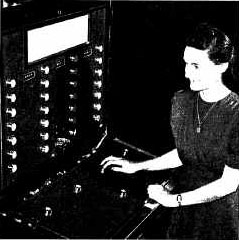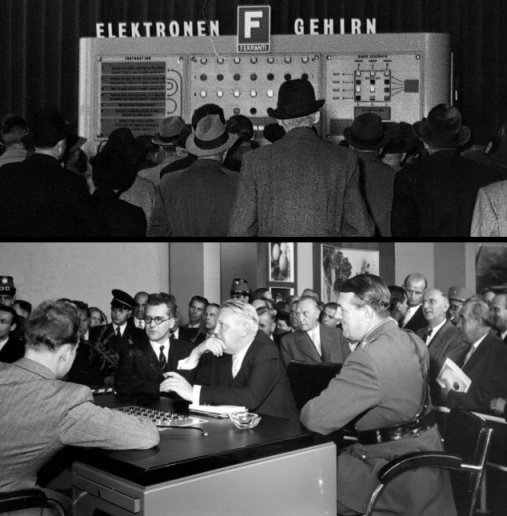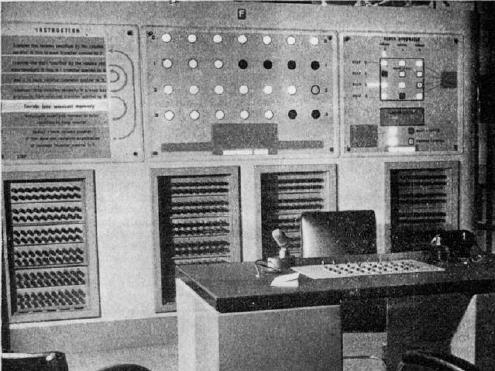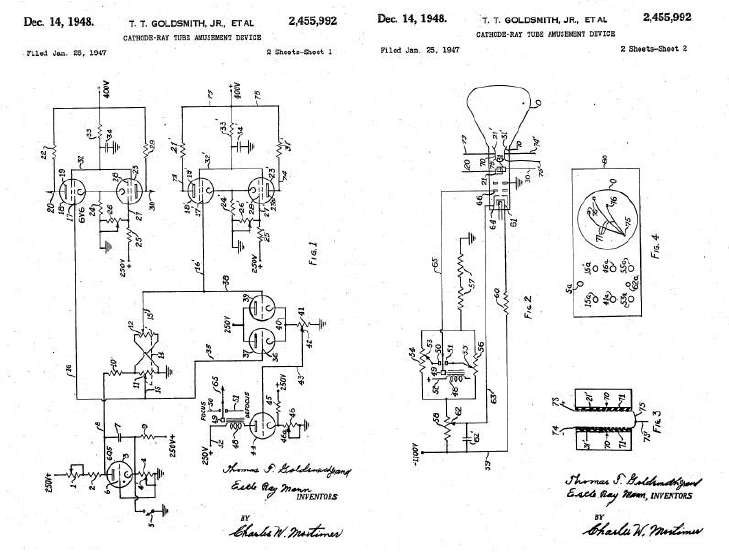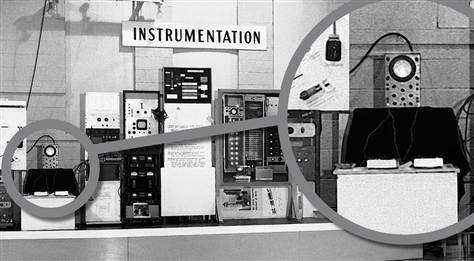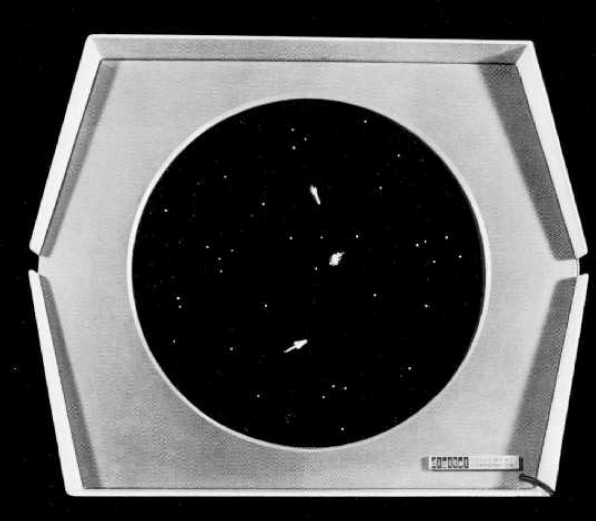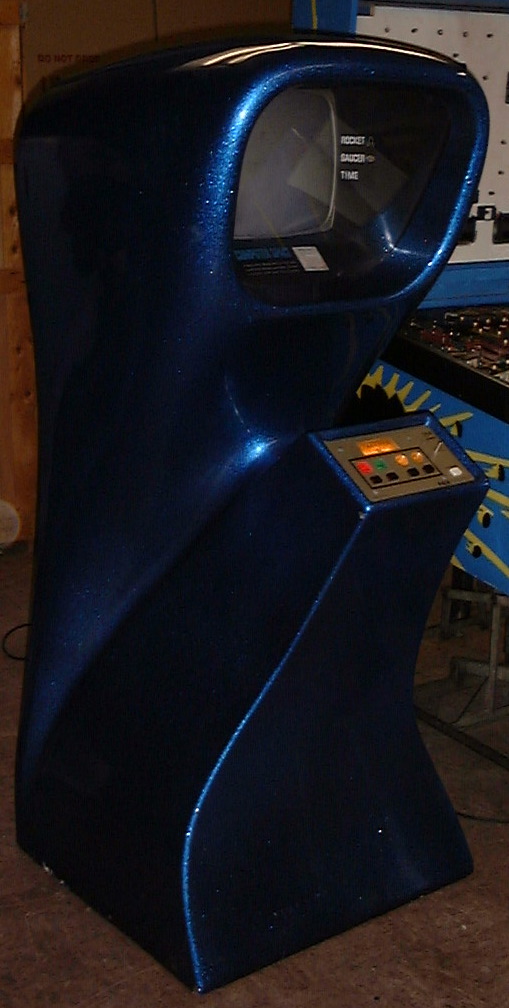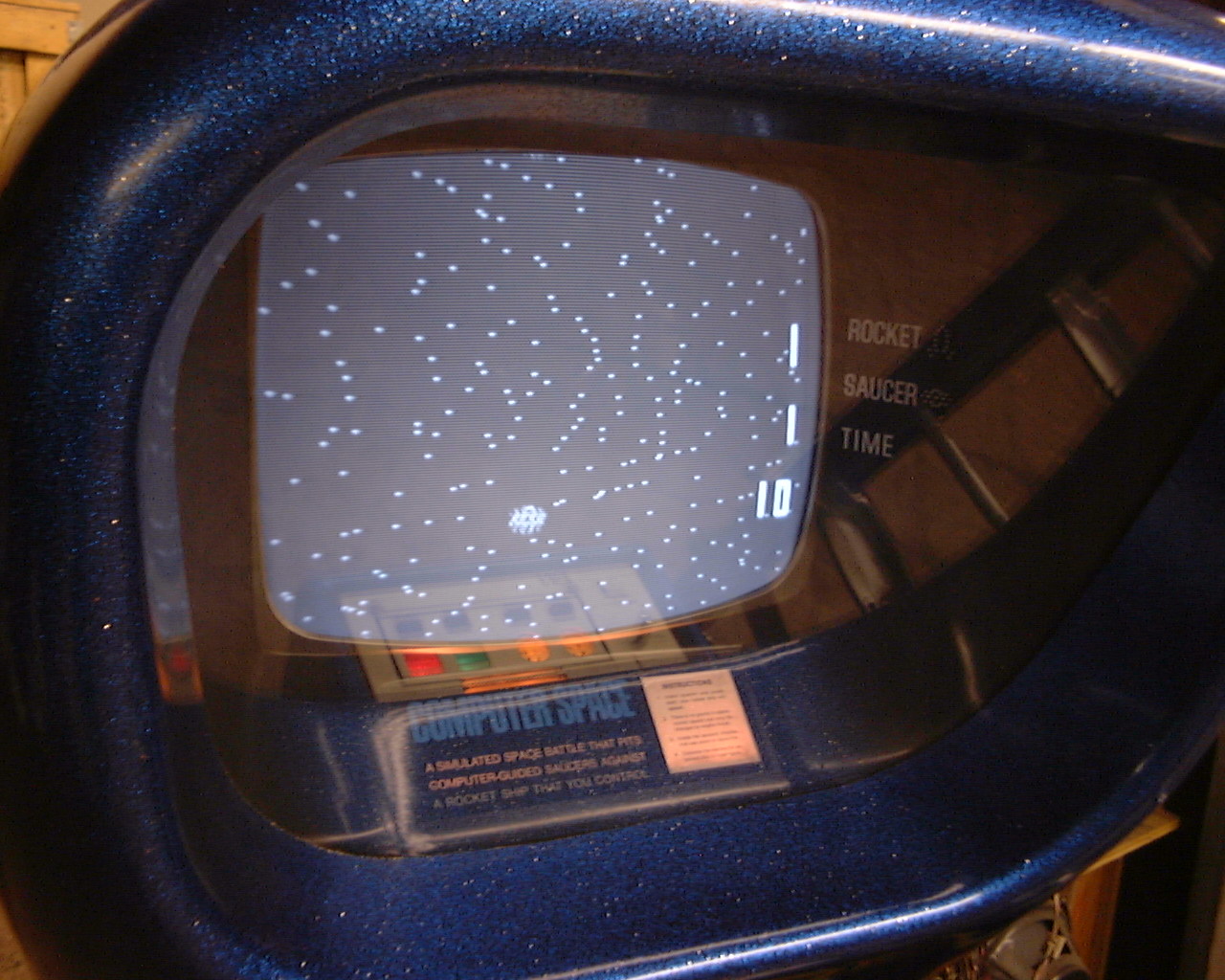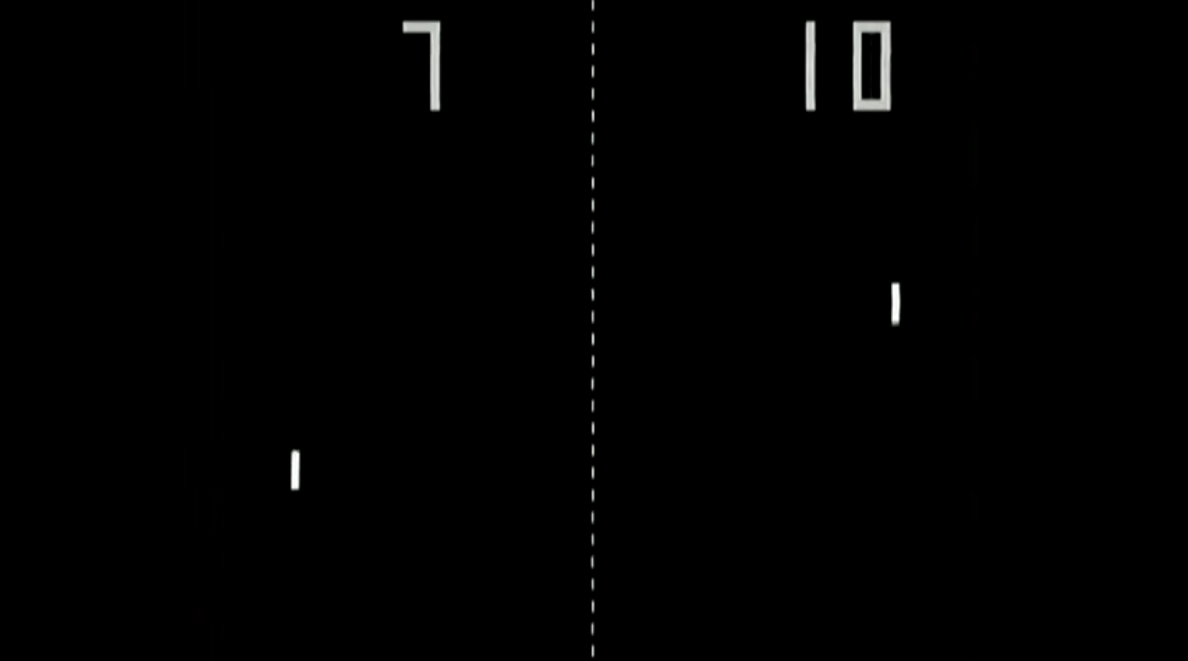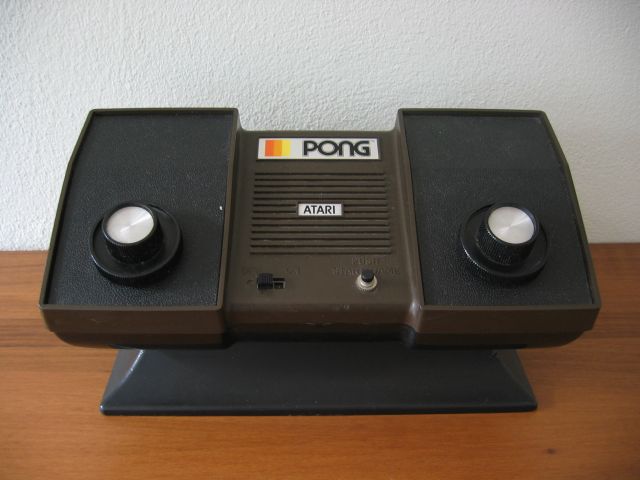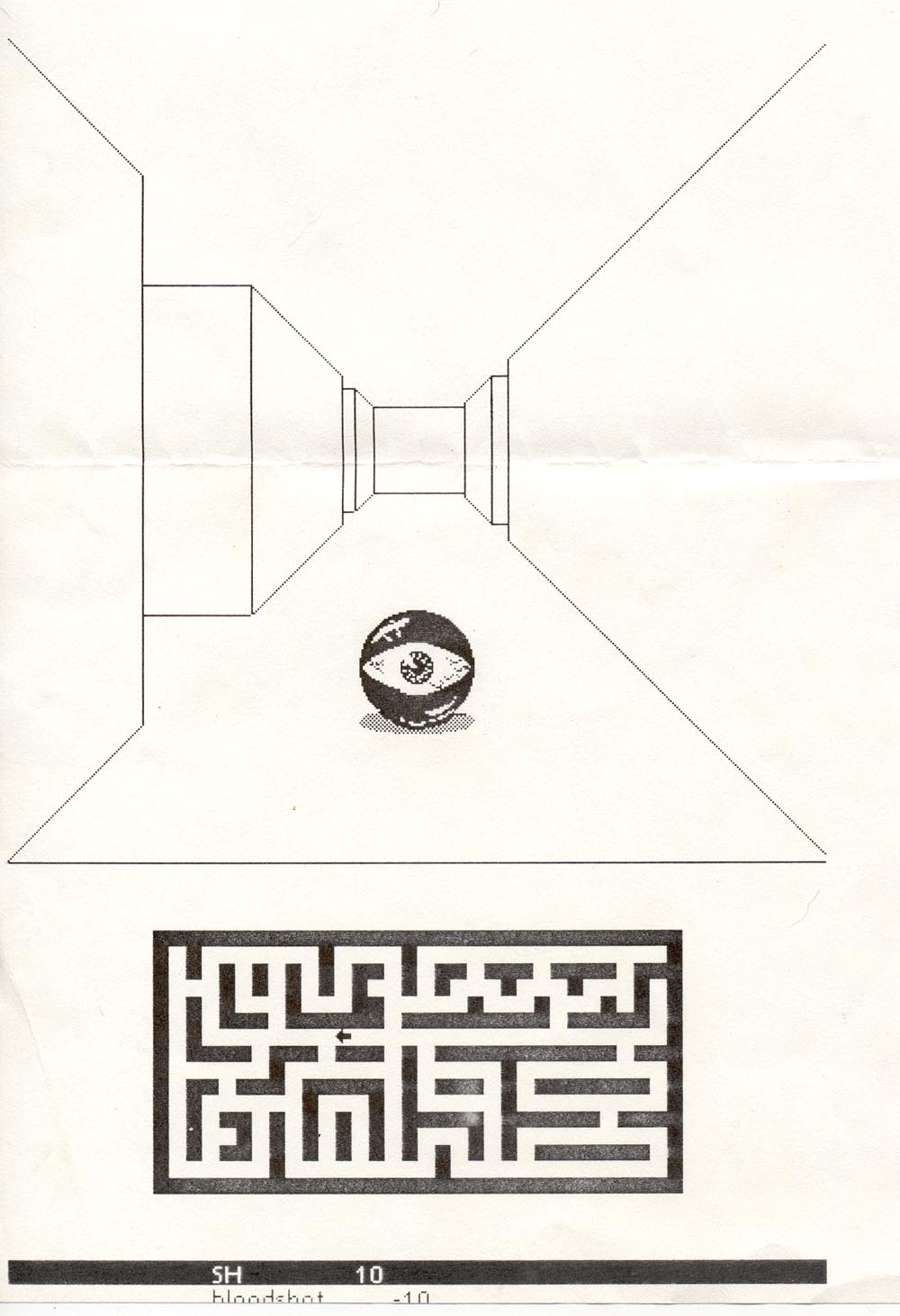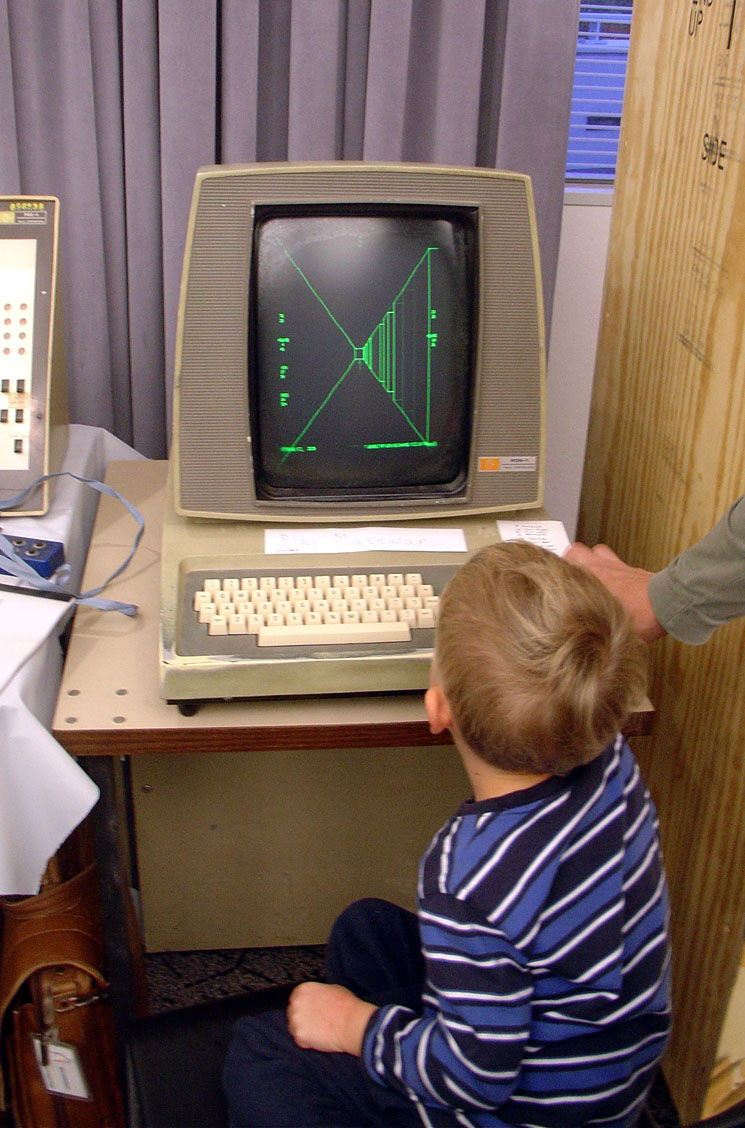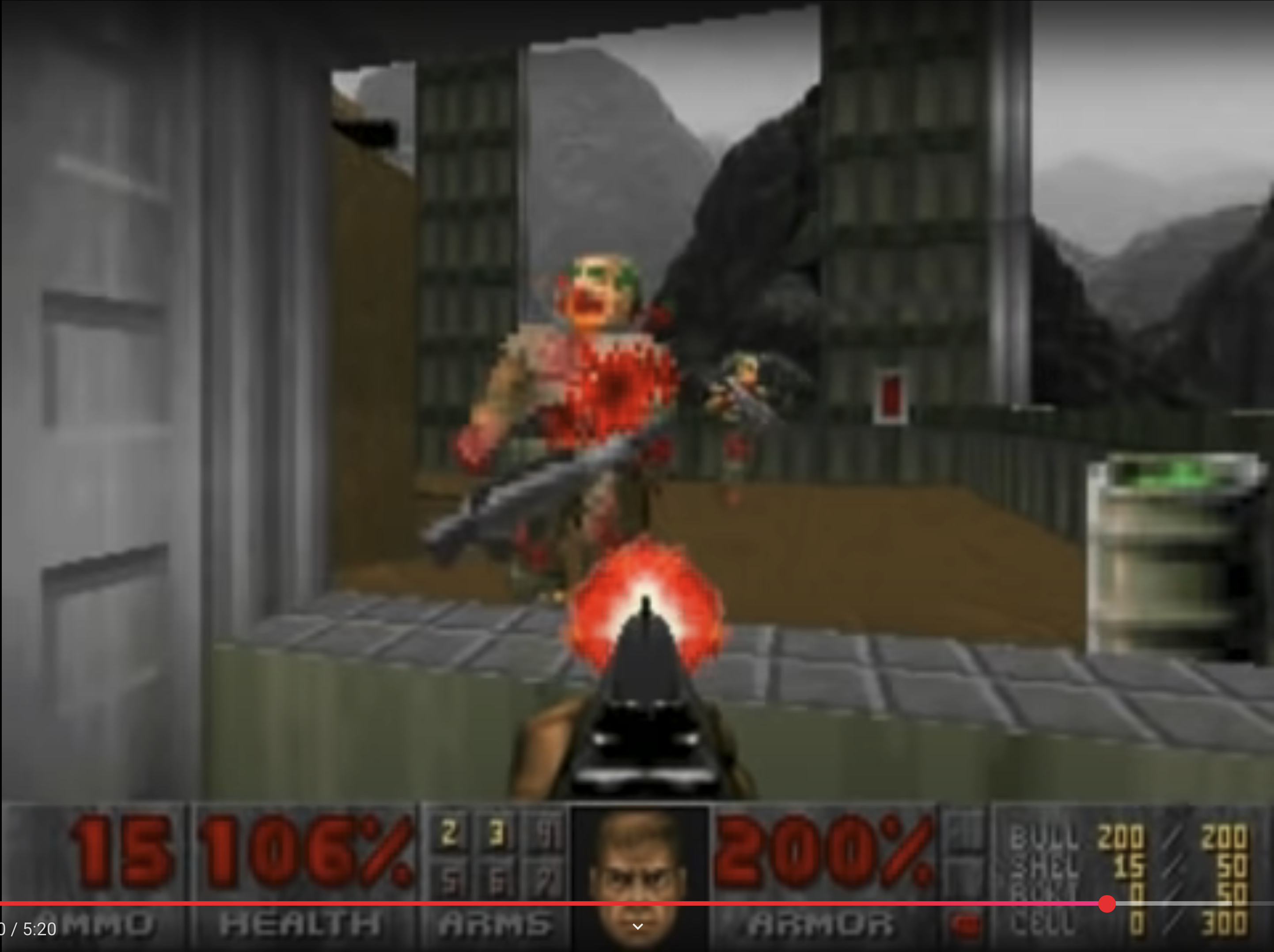IASLonline NetArt: Theory
Thomas Dreher
History of Computer Art
VII. Games
VII.1 Computer and Video Games
- VII.1.1 Early Computer Games
- VII.1.2 Arcade Games and Consoles
- VII.1.3 First Person Shooter & Third Person View
- VII.1.3.1 Ego Shooter
- VII.1.3.2 God Games
- Illustrations Part X: Computer and Video Games: PPT / PDF
- Table of Contents
- Bibliography
- Previous Chapter
- Next Chapter
Since the beginning of the 16th century the game "Nim" is known in Europe. Two players alternate in their efforts to remove matchsticks from a series of matches. The players decide how many matches they remove. According to the agreement about the goal of the game each player tries either to cause or to prevent the situation to hold the last matchstick.
When in the thirties Patrick Michael Grundy and Roland Parcifal Sprague used Nim as a model case to investigate conditions of impartial games then they discovered independently from each other the Sprague-Grundy-theorem now fundamental to the mathematical game theory. 1 This model status exposed Nim beside chess: Both games offered points of departure for further far-reaching developments from which computer games emerged.
Since 1940 machine versions of Nim players were realised. They are variants of early electronic games processing a classic games´ set of rules (see below). The goal of the Nim machines was a reconstruction of the game logic. In the meantime, in 1948, inventors started with the "Cathode Ray Tube Amusement Device" (see below) 2 a development line constructing machines for the game action of hitting.
In 1940 Edward U. Condon, Willard A. Derr and Gereld L. Tawney received the U.S. Patent 2,215,544 for a Nim machine being able to play the two game strategies following the rules of either the "normal case" or the "reversed case" against a human competitor. In spring 1940 the machine called "Nimatron" was realised by the firm Westinghouse for the New York World´s Fair. "Nimatron" had a weight of more than a ton "and [the circuit] ma[de] extensive use of relays". 3
Condon, Edward U./Derr, Willard A./Gereld L. Tawney:
Nimatron, 1940.
Left: Realisation by the Westinghouse Electric & Manufacturing Company,
spring 1940, New York World´s Fair (source: The American Mathematical
Monthly. Vol 49. January 1942, p.42ss.) .
Right: Illustration of U.S.
Patent 2,215,544.
In 1948 Raymond Redheffer presented a Nim machine realised with "simple electrical circuits" weighing "about five ponds". The machine can not only be used to play with four rows of matchsticks but also for an arbitrary amount of them. According to Redheffer a precursor of this machine was just planned in 1941-42 for a realisation with relais. 4
Redheffer, Raymond: Nim, box realised in using blue plexiglass, signed with "Raymond Redheffer MIT" (film by Mike Mozart, including some not quite correct informations according to the current level of knowledge).
A box made with blue plexiglass was found at antique markets being signed with "Raymond Redheffer MIT" (Massachusetts Institute of Technology, Cambridge/Massachusetts). This box was named "Nim". This box seems to be one of the realisations of Redheffer´s concept.
When in 1951 the "Exhibition of Science" was a part of the "Festival of Britain" in London, then one of the exhibits was a game computer constructed by John Bennett and Raymond Stuart-Williams. The exhibition was installed in a new wing of London´s Science Museum in South Kensington. The Ferranti Nimrod was a digital computer consisting of 480 tubes to play Nim with a human competitor. A table contained buttons and lights to control computing processes. A demonstrator sat at this table turning his back to the computer, meanwhile a visitor sat at the other side of the table facing the front side of the Ferranti Nimrod. This front included three slabs with control lights: A list with the steps of the computing process (left), the score (center) and the computing processes for the rows of game elements (right) were displayed. 5
Bennett, John/Stuart-Williams, Raymond: Ferranti Nimrod,
1951.
Left: Industrial Exhibition, fair grounds, Charlottenburg/Berlin, opening
day 6th October 1951, Federal Minister of Economic Affairs Ludwig Erhard
(left bottom, at the centre) plays against Nimrod and looses three times
(Borchers: Jahre 2001. Source of the images: Heinz Nixdorf MuseumsForum,
Paderborn).
Right: Exhibition of Science, Science Museum, South Kensington/London,
Part of the Festival of Great Britain, London 1951.
Within the exhibition parcours leading from physics, chemistry and biology to the outer space the computer was placed in the center of the fifth and last room. Jacob Bronowski wrote for the booklet of the exhibition:
You are plunged headlong through these five rooms into the structure of matter, and are now ready to see, in a more leisure way, how we come to know about it. 6
The Ferranti Nimrod acts in the last exhibition space as an example for the "electronic brain". Beside the cosmic space, stars and lightbeams "which reach us from outer space" the "electronic brain" is mentioned as one of "a range of subjects from the electronic brain to the processes and structures on which life is based". 7
In a further booklet "NIMROD" the Ferranti Nimrod is compared with the mainframe computer Ferranti Mark I (1951, see chap. III.1) by the Manchester University. The booklet points to Ferranti Nimrod´s computing capacity to solve "quite complex problems" despite its "small memory" in comparison to the mainframe computer. The digital Nim game is presented to demonstrate the computing capacities of the Ferranti Mark 1.
In the booklet on "NIMROD" the term "electronic brain" is explained as not useful because it provokes false expectations concerning autonomous thinking capacities of machines:
[Automatic computers] do `think´ after a fashion but only in the manner that their designer and the person controlling the machine allow. 8
The Nim game presented a model of the mathematical game theory (see above) and it was used as a test case for the capacities of "automatic computers". 9
In the last space of the "Exhibition of Science" the imagination of a scientific cosmos was provoked by exhibits exemplifying games, mathematics, electronic calculation and cosmic space. As its contribution to the "Festival of Britain" the "Science Museum" offered to its visitors a parcours showing glimpses into the scientific cosmos. On its exhibition fairground at London´s South Bank the festival offered a collection of the best British achievements in industries, arts and sciences. Beside this exhibition area further exhibitions in areas within and outside London were installed.
The festival of achievements did not seek direct comparisons for example between Great Britain and the United States of America in cases like the machine-made Nim competitors Ferrant Nimrod and the little box developed at the MIT (see above).
In 1950 Claude Elwood Shannon presented guidelines of a chess program for computers. He explored ways to analyze chess and to use it as a precondition to develop a program. Because the possible moves were too many for the contemporary computing capacities Shannon proposed to reduce them so far that they still enable the program to unfold "a skillful game, perhaps comparable to that of a good human player." 10 Shannon explained the problems to be solved in programming:
Our problem is to represent chess as numbers and operations on numbers, and to reduce the strategy decided upon to a sequence of computer orders. 11
In 1951 Dietrich G. Prinz developed a chess program for the Manchester Mark I (since 1949) analysing all possible moves. Because of the computer´s limited memory capacity the program could not solve more than some of the problems a player has to solve if a checkmate is possible in two moves. The computing with the program needed more time to find a solution than a human player. 12
In 30th July 1951 a program for a checkers game, developed by Christopher Strachey, was installed on the Pilot ACE of the National Physical Laboratory in Teddington/Middlesex (1950-55, see chap. III.1.2). But the memory capacity of this mainframe computer was too small. In consequence, Strachey rewrote his program of a checkers game in October 1951 using the machinic game of the Manchester Mark I, the precursor of the Ferranti Mark I. 13
The programs and machines presented above are a part of the video and computer games´ prehistories. The presented games take up characteristics of elder games like the logics of rules structuring the progression of plays. Apparently in the English context of the Manchester University and Ferranti Ltd. as well as in the U.S.A. at the MIT (Redheffer´s employer) and at the Bell Telephone Laboratories (Shannon´s employer) scientists treated problems of programs for games as if they were solvable tasks.
Shannon wrote about the significance of chess programming:
Although perhaps of no practical importance, the question is of theoretical interest, and it is hoped that a satisfactory solution of this problem will act as a wedge in attacking other problems of similar nature and of greater significance.
Games offer developers test cases to be used in the creation of "modern general purpose computer[s]". So for Shannon chess was sufficiently complex and in its structure with goal-oriented steps it was particularly suitable for the exploration of the "digital nature of modern computers". 14
In 1948 Thomas T. Goldsmith Jr., Cedar Grove and Estle Ray Mann received the U.S. Patent #2,455,992 for their invention of a "Cathode Ray Tube Amusement Device". This never realised device was designed to change the course of a point on a cathode ray tube via knobs. The moving point should constitute a curved line and the knobs should serve to navigate the point to a target. The target should be marked by an overlay on the tube: For a player the moving point should be a bullet hitting or missing a plane. The "Amusement Device" was already a concept for a shooting game. 15
Goldsmith Jr., Thomas T./Grove,Cedar/Mann, Estle Ray: Cathode Ray Tube Amusement Device. U.S. Patent #2,455,992. 1948, Sheets 1 and 2, fig.1 - 4.
At the University of Cambridge (Cambridge/Cambridgeshire, England) Alexander S. Douglas wrote a doctoral thesis on the human-machine interaction. In 1952, as a demonstration of his thesis, he developed a program to play "Tic Tac Toe" on the mainframe computer EDSAC (Electronic Delay Storage Automatic Calculator, Mathematical Laboratory, University of Cambridge, since 6th Mai 1949). EDSAC´s three cathode ray tubes (with 35 x 16 pixels) presented the game with its basic division in nine fields. With a telephone dial the fields could be marked with "X" or "O" on a rotational basis by the player or the computer. When a player or the computer succeeded to set his or its mark in three fields beside each other – in a horizontal, vertical or diagonal order – then the winner of the game was found. 16
Douglas, Alexander S.: Tic Tac Toe, 1949, game for the mainframe computer EDSAC (illustration: Tic Tac Toe in the EDSAC Emulator).
Contrary to the patent by Goldsmith, Grove und Ray (see above) Douglas´ game is not an electronic game with new rules. Nevertheless the development of computer games containing the monitor presentations as an important part of the interface (as the access of the player to the game system) started in 1949 with Douglas´ version of "Tic Tac Tow". After the rules and moves of classical games have been programmed the next important step in the evolution of computer games was to develop games for monitor presentations.
The nuclear physicist William Alfred Higinbotham was the director of the Instrumentation Division at the Brookhaven National Laboratory in the U.S. Department of Energy (DOE, Upton auf Long Island). For the visitors´ day at 18th October 1958 Higinbotham invented an exhibit provoking visitors to interactions. With his object he reacted to the lack of interest "in static exhibits" as visitors demonstrated it in earlier public presentations. 17
Higinbotham, William: Tennis for Two, 1958, Systron Donner Analog Computer, Germanium transistors, oscillograph (diameter: 5 inches), 2 boxes with turning knobs and press keys. Exhibited at the visitor´s day of the Instrumentation Division at the Brookhaven National Laboratory, U.S. Department of Energy, Upton/Long Island ("Tennis for Two" is presented enlarged in the wider circle. Image source: Brookhaven National Laboratory).
When reading the instruction book of a Systron Donner Model 30 analog computer (1954-60) Higinbotham found a description "how to generate various curves on a cathode-ray tube of an oscilloscope, using resistors, capacitors and relays. Among the examples...were the trajectories of a bullet, missile and bouncing ball all of which were subject to gravity and wind resistance." Higinbotham reminded the instruction book´s game ball of a tennis game. In constructing "Tennis for Two" he combined the little analog valve computer with an oscillograph (with a diameter of 5 inches) and two portable boxes, each of them with a turning knob and a press key.
Higinbotham, William: Tennis for Two, 1958, Systron Donner Analog Computer, Germanium transistors, oscillograph (diameter: 5 inches), 2 boxes with turning knobs and press keys. Exhibited at the visitor´s day of the Instrumentation Division at the Brookhaven National Laboratory, U.S. Department of Energy, Upton/Long Island (Peter Takacs explains a version of "Tennis for Two", reconstructed in 1997).
The oscillograph showed the vertical plan of a tennis court: A long horizontal floor line was interrupted in its middle by a short vertical line representing the tennis net. The players could influence the curve of a point in using the turning knobs on the boxes. The press key caused the racket to push the ball. The racket was reduced to a movable short vertical line. The rackets appeared on both sides of the tennis court´s vertical plan. Higinbotham and Robert V. Dvorak, the executing "technical specialist", accelerated the moving parts with Germanium transistors. They were available only since recently:
At that display rate, the eye sees the ball, the net, and the court as one image, rather than as three separate images. 18
For "Tennis for Two" non-sporty games were selected no longer as a base, as it was the case in the development of former computer games´ programs (see the examples above), rather the idea of a point moving on a cathode ray tube – as it was anticipated in the patent by Goldsmith, Grove and Ray – was taken over for a reduced representation of a game play borrowed from sport. "Tennis for Two" was not yet able to record, store and indicate the score.
In 1961 J. Martin Graetz, Stephen R. Russell and Wayne Wytanen were employed in the Littauer Statistical Laboratory of the Harvard University (Cambridge/Massachusetts). According to Graetz´s report from the summer of 1961 he became acquainted with the transistor-equipped mainframe computer TX-0 (1955/56, developed at the MIT Lincoln Laboratory) at the MIT (Massachusetts Institute of Technology, Cambridge/Massachusetts) Electrical Engineering Department. Graetz got to know demonstrations realised for the TX-0 and its interface with a mouse, a console and a lighting pen. 19 These demonstrations inspired the development of a computer game´s programme for the minicomputer DEC (Digital Equipment Corporation) PDP-1 (since 1960) and its vector screen. In a room the PDP-1 was placed next to the TX-0. Alan Kotok, member of the TX-0 research group, as well as Dan Edwards and Peter Sampson, co-workers at the artificial intelligence research team, contributed to the development of "Spacewar!".
Edwards, Dan/Graetz, Martin J./Kotok, Alan/Russell, Stephen R./Sampson, Peter/Wytanen, Wayne: Spacewar!, 1962, computer game for the minicomputer PDP-1, screen with two spaceships.
In February 1962 the first version of "Spacewar!" was installed on the PDP-1. It consisted of two spaceships. Their forms presented on screens of cathode ray tubes are described by Graetz as "needle and wedge space ship outlines". The players used a knob on their "control boxes" to direct the rotation of the ships. 20 Beside the turning knob for the spaceship the box had a further turning knob with a double function: In moving the knob back the rocket was accelerated, meanwhile in pulling the knob forward the hyperspace function was started. Players could activate this function if they didn´t recognize another way to escape in fields anywhere between adversaries and the gravitational centre. The function could be used three times. After the escape the spaceship returned to arbitrary places on the playing field – in the worst case to the later developed gravitational centre (see below). The push button of the "control box" made it possible to start a torpedo consisting of small square points of light. This "torpedo" could be used to kill the adversary.
Edwards, Dan/Graetz, Martin J./Kotok, Alan/Russell, Stephen R./Sampson, Peter/Wytanen, Wayne: Spacewar!, 1962, computer game for the minicomputer PDP-1, console.
For a more interesting gameplay a gravity field was developed for the centre of the monitor and located in the area surrounding a star with flashing beams: Not moving spaceships were drawn into this centre of gravity.
The spaceships had to be moved to evade the projectiles of a competitor (who behaves like an enemy in the case of "Spacewar!") and not to be drawn into the centre of gravity. To reduce the necessary computing capacity the projectiles are not subjected to the forces of gravity. The authors tried to explain this absence of gravity with the makeshift explanation to connote projectiles as "photon bombs." 21
The statistics of points made it possible to limit the duration of a game to the time span necessary to reach a determined number of points.
At the end of April 1962 the second version of "Spacewar!" was installed. In May 1962 it was presented to the public at the day of the "Science Open House".
The Digital Equipment Corporation delivered the PDP-1 with "Spacewar!" as a program to be used to test the performance of the processor and the screen. 22
With "Spacewar!" the development of the computer games converged with the contemporary technology of minicomputers: The pioneer of minicomputers was the DEC PDP-1 being delivered since 1960. "Spacewar!" is the first shooter game for a monitor display, and its interface prefigures joysticks.
In the seventies the commercially successful successors of the shooter game consisted of simplified game systems (see chap. VII.1.2). The distribution of "Spacewar´s" game system as open source code points to another cultural context as the one of the entertainment industry determining the development of the video games (see chap. VII.1.2). 23
In the fifties and sixties games for mainframes and minicomputers were only able at public demonstrations to reach an audience larger than the circles of academic experts trained in the use of computers (see chap. VII.1.1). In the seventies the "arcade games" became electronic games in coin-operated machines accessable for a wider public in amusement halls 24, meanwhile the consoles for televisions transformed the living rooms – (since the sixties) the usual site for television – into a place for gaming. 25
The first arcade game "Computer Space" was sold since 1971. Nolan Bushnell developed it for Nutting Associates. Ralph Baer constructed "Odyssey" as a console connected with television. Magnavox distributed "Odyssey" since January 1972. "Spacewar!" (see chap. VII.1.1) was transformed in "Computer Space" into a game machine with a TV monitor in a futuristic designed fibreglass housing and an protruding keyboard, meanwhile the tennis game of the "Odyssey" console changed Higinbotham´s "Tennis for Two" (see chap. VII.1.1) into a `living room game´. 26
Bushnell, Nolan: Computer Space, Nutting Associates,
1971, arcade game.
Left: the case. Right: the screen.
Baer transformed Higinbotham´s sideview of a tennis game into a top view. A small square represented the ball. It was moved between two big squares symbolising the rackets. A transparent foil contained a vertical line representing the tennis net.
The "Odyssey Home Entertainment System" included a control unit and two boxes with knobs used in the tennis game for moves with the rackets. The black/white graphics could not present other elements than points and lines. It was not yet possible to store and indicate stores.
Baer, Ralph: Tennis, one of the twelve games included in the Odyssey Home Entertainment System, Magnavox, 1972. Players with the console being connected to the TV.
Six movement patterns and twelve screen foils were the elements of twelve games, among them the tennis game described above. The movement patterns were installed in selecting one of six plugs interconnecting "conductors". 27
Baer, Ralph: Odyssey Home Entertainment System, Magnavox, 1972, console for twelve games, presentation in Commercials and TV Appearance, 1972-1973.
The sales of "Computer Space" and "Odyssey" fell short of their producers´ expectations: The technology of the arcade games and consoles became successful with later developed products mainly consisting of simplifications.
Nishikado, Tomohiro: Space Invaders, Taito, 1979, arcade game.
The adaptation of "Spacewar´s" gravity in the arcade game "Computer Space" and its thick user´s manual were reduced in "Space Invaders" (1978, Taito/Midway) 28 and "Asteroids" (1979, Atari) 29 to simple shooter games with one "source of risk". 30
Rains, Lyle/Logg, Ed: Asteroids, Atari, 1979, arcade game.
After the "Odyssey Home Entertainment System" for several games a market arose for game consoles with hard-wired components for only one game. Since 1976 multifunctional consoles were available. They were made with chip technology for games on "cartridges": If a cartridge were inserted into the console than another game could be started. 31
Among the arcade games "Pong" (1972, Atari) became the most widely played tennis game. Like "Odyssey" it was a successor of "Tennis for Two", but it included a score. "Pong" belongs to the first successful games of Nolan Bushnell´s firm Atari.
Alcorn, Allan: Pong, Atari, 1972, arcade game.
The Atari engineer Allan Alcorn divided the vertical lines representing tennis rackets in eight sections. If the square used as a ball hit the midst of the racket line then the square was bounced off at a right angle to the racket but diagonally (at a 45 degree angle) in all other sections. After longer playing times the ball moved faster. 32
Three month after the first delivery of "Pong" Atari was faced with the first imitators. 33 With "Home Pong", made available on the toy market since Christmas 1975, Atari started its engagement as a producer of consoles. 34 Since 1977 Atari´s multi-game console VCS/2600 (VCS = Video-Computer System) was sold successfully. 35
Alcorn, Allan/Brown, Bob/Lee, Harold: Home Pong, Atari, 1975, game console.
In Christmas 1977 the video game market suffered a crisis because too few interesting games were offered for the deliverable consoles. Atari survived the crisis without the financial problems of other game producers. With new games Atari initiated between 1979 and 1982 the reinvigoration of the games industries. In these times Japanese producers like Taibo, Namco and Nintendo rushed to the market hitherto dominated by American firms. 36
After its original delivery in 1982 the personal computer Commodore 64 (1982-94) became famous as a game platform. In this function it overcame its rivals produced by Apple and Atari. 37 Because of stronger computing capacities initially the consoles were more appropriate for games affording fast player movements but this advantage vanishes with further developed technology of personal computers. After the game industry´s second crisis from 1983 to 1985 personal computers and consoles were competing platforms for games. 38
In the eighties and nineties the shooting games were developed further offering to the player a simulation of a weapon in the lower field of the screen. After having recognised ennemies the player shoots with his weapon on his run through three-dimensional animations simulating sequences of spaces (First Person Shooter or Ego Shooter). In the game genre "Management Simulation" not the affordance to shoot constitutes the primary goal of players but the selection of elements and properties constituting a game world with affordances to make further decisions (Third Person overview of God Games, see chap. VII.1.3.2).
In 1973 Steve Colley was confronted with the task to develop a program for simple 3D animations, among them line displays of labyrinths, and to implement it on the minicomputer Imlac PDS-1 (since 1970, with a vector graphics coprocessor) of the NASA/Ames Research Center (Computation Division, Moffet Field/Kalifornien).
A result of the communications between Colley, Howard Palmer and Greg Thompson was the plan, to program a labyrinth for humans moving in it. Considering the limited computing capacity Palmer proposed a labyrinth allowing only movements in a 90 degree angle. For this kind of navigation Colley programmed a labyrinth.
Colley, Steve/Palmer, Howard/Thompson, Greg: Maze War,
1973-74, game for the minicomputer Imlac PDS-1.
Left: printout of a screenshot (from an implementation on the personal
computer Xerox Star 8010), 1985-86.
Right: child playing Maze War on an Imlac PDS-1, 30th
Maze War Anniversary Event, DigiBarn Computer Museum, Mountain View/California
6th-7th November 2004.
The moves of two players in the labyrinth were recorded in "using the serial ports" (Colley) of two Imlac PDS-1 computers connected by a local area network. In "Maze War" the players´ moves were presented on monitors. 39 They could see their position in a 3D animation presenting the edges of the walls as lines and on a floor plan of the labyrinth. The floor plan showed only the position of the player without the competitor, meanwhile the 3D animation presented the game state. In this view the competitor was presented as a ball with an eye. The position of the eyeball indicated which player hit the other one.
Players navigated through the labyrinth in using five keys of the keyboard: four keys for the navigation in four directions and one key for shooting. When a player entered new rooms then he could look around for a short time before he had to shoot.
This version was realised from 1973 to 1974 and in 1974 expanded by Greg Thompson to include a system for many players: When Imlac computers were connected via the ARPANET (see chap. VI.1) with a server (DEC PDP-10, 1964-83) then eight players could compete with each other in "Maze War". 40
Although "Maze War" as well as "Spasim" (1974) are said to be the origins of the game genre ego shooter, both 3D games did not yet include a simulation of the player´s weapon. "Spasim" was a space game representing starships and four planetary systems only as wireframe models meanwhile "Maze War" already eliminated the hidden lines. From January to March 1974 James Allen Bowery programmed "Spasim" for the PLATO (Programmed Logic for Automated Teaching Operations) system. Since 1960 the PLATO system was developed and evolved by the Control Data Corporation for e-learning.
Bowery, James Allan: Spasim, 1973-74, multiplayer online game for the PLATO (Programmed Logic for Automated Teaching Operations) system.
Up to 32 participants could play "Spasim". In PLATO IV terminals with monochrome plasm screens were connected to the mainframe computer CDC Cyber 6400 of the Computer Based Education Research Laboratory (CERL, Urbana/Illinois), like the earlier 2D game "Empire" being programmed by John Daleske for 8 players in April/May 1973. Since July 1973 players of "Spasim" could change their point of view in using the keys QWEADZXC for 8 directions. Also players could use the "+" and "-" keys for acceleration and speed reduction. In the game world players are represented as starships. In each planetary system eight team players could shoot with "phasers-and-photon-torpedos". 41
Also the simulation in Attari´s arcade game "Battlezone" (November 1980) consisted of wire frame models. A player had to fire on a tank. This task had to be fulfilled successfully before the tank changes his tour between both sides of the screen, turns his front in the player´s direction and fires on him. The ennemy´s weapons included slow standard tanks as well as faster tanks and anti-tank missiles.
Rotberg, Ed/Hoff, Morgan: Battlezone, Atari, 1980, arcade game.
The player targeted with a linear representation of a gun sight indicating the periscope of a tank. Players could only fire straight ahead. Because no other function than shooting was offered for the game play "Battlezone´s" action functions are reduced compared to "Spasim".
The vector graphics presenting wireframes (based on polygon elements) become brighter from back to front. The animation is supported by green and black overlay transparencies. The representation of a periscope´s cross-hair was supplied by a transparency on the black-white monitor. The transparency simplified the cognition if and when ennemy objects appeared in the target area. With the representation of the cross-hair as a part of the player´s weapon "Battlezone" got an important element of future ego shooters that was not yet included in the 3D animations of "Maze War" and "Spasim".
Players navigated with two joysticks comparable to a tank driver´s control sticks. A radar screen shown at the center of the top presents targets as points. Already "Maze War" combined a perspective view with a top view of the game space (see above). This combination will be repeated in "Doom" (1993, id Software, see below). 42
In the ego shooters for home computers "The Eidolon" (1985, Lucasfilm) and "MIDI Maze" (1987, Hybrid Arts) the wireframe models were substituted: in the first named game by fractals and in the second game by coloured flat areas.
Kellner, Charlie/Seleme, Lance: The Eidolon, Lucasfilm Games/Epyx, 1985, computer game.
In "Eidolon" the player navigates in caves suggested by dotted lines and shoots on helicopters, fireballs, dragons and other monsters, meanwhile an instrument panel at the bottom of the screen indicates the score.
In "MIDI Maze" (1987) the players´ computers (Atari ST, 1985-93) are connected with each other via a MIDI (Musical Instrument Digital Interface) network. In a labyrinth the players navigate in four directions and they target at competitors represented as smileys (yellow icons presented as faces). The weapon is presented only as a red target rectangle. The players try to direct this red rectangle onto the smileys. 43
Xanth Software F/X: Midi Maze, Hybrid Arts, 1987, computer game.
In "Wolfenstein 3D" (1992, id Software, computer game) the maze-like sequences of rooms limited by vertical planes representing walls were taken up from "Maze War" and "MIDI Maze" and constitute the game space for a player´s run through a sequence of rooms in fighting against ennemies. The player acts in the role of the fictive American soldier William "B.J." Blazkowicz being imprisoned in the NS-Ordensburg Wolfenstein. His fighting path out of the Ordensburg is limited by vertical planes simulating stone masonry and decorated with Nazi emblems as well as Hitler portraits. In these rooms he is confronted with German soldiers, SS men and shepherd dogs. They are the ennemies to fight against in actions of shooting (In 1994 the game was confiscated in Germany because of infringements against the penal code´s § 86a Section 1 Nr. 4 prohibiting the use of forbidden organisations´ signs).
id Software (Romero, John/Carmack, John/Hall, Tom): Wolfenstein 3D, Apogee Games, 1992, computer game.
In Wolfenstein 3D, as before in "MIDI Maze", the rooms are simulated without ceilings: Both games contain animations of maze-like sequences of spaces limited at the sides and in the depths by walls of the same height. In "Wolfenstein 3D" the weapon protrudes in these rooms. Because of the lamps with green shades the monochrome dark grey horizontal upper areas become readable as ceilings. The floor appears monochrome grey, too. But the floor is more light-coloured than the ceiling.
The 3D animation in "Wolfenstein 3D" is based on polygons. This animation was realised in using "Raycasting". "Raycasting" algorithms are developed to remove the surfaces of simulated objects being hidden from the player´s perspective. With this "rendering technique" a "pseudo-3D" imagery is calculated with data from two-dimensional maps. The walls of the ground plan are scanned with light rays from one point of view in one image line. These rays became the basics for the calculation of occlusion. Because of the specified geometric rules the ground and the walls have always the same height. No other walls than the ones with right angles are represented. In using these rules John Carmack realised in "Wolfenstein 3D" an early example for "Raycasting". 44 The walls got their textures with "sprites" being set by a graphic processor in the programmed image position. 45 In 1992 the increased capacities of computers with processors being cheaper than ever before paved the way for the programming of "Wolfenstein 3D´s" graphic engine.
id Software (Romero, John/Carmack, John/Hall, Tom): Doom, Cdv Software Entertainment, Pearl Agency, 1993, computer game.
In 1993 the design team of id Software (John Romero, John Carmack, Tom Hall) presented "Doom" (computer game), and with its graphic engine they set a new standard for 3D graphics. Like its predecessor "Wolfenstein 3D" the engine of "Doom" was based on "Raycasting": In "Doom" floors are not more than horizontal planes and the walls are only vertical. Now the walls of "Doom" have different heights and touch each other at whatever angle. The planes and ceilings of the combat rooms are created with textures. Ennemies, weapons and other objects were integrated as two-dimensional sprites into the virtual environments. 46 Meanwhile in "Wolfenstein 3D" the possible moves were restricted to two axes, they where enlarged in "Doom" to three axes. Sometimes a well visible hand lifts the weapon high into the image field.
The representations of labyrinths from "MIDI Maze" to "Wolfenstein 3D" is superseded in "Doom" by corridors widened to rooms with forking corridors. Several times the game architecture includes prospects on landscapes.
The player can find weapons during his passage through the sequence of rooms, and he can take them up in passing the find sites. These weapons can be hidden in parts of the game architecture making it difficult to find them. In searching such sites the player can switch into the map view: The indicated past paths of the player can serve him to find out unresearched places. 47 To proceed his path in running and fighting the player has to solve riddles, too.
"Doom" included four episodes, each of them contained nine levels. Each level offered to players rooms with ennemies and obstacles for running and fighting. "Doom" is an early example for the classical structure of ego shooters consisting of an environment´s exploration, fighting and task solving. 48
The narrative framework to these paths for running fighters came from a science fiction stored in the "Doom Bible" by Tom Hall until Cormack decided to give it up. Cormack explains the status this story can have for players:
Doom didn´t need a back story. It was a game about fight or flight. 49
The speed necessary to react in "Doom" to shooting ennemies causes players to run on each level as fast as possible. In "Speed Runnings" veterans of "Doom" reduced the time necessary for all levels to the record of five minutes. The courses of matches could be stored on a demo file. Players could distribute these files on the internet and communicate about their skills. 50
If the perspective of a game´s figure is identical with the view of a player on the screen then it is comparable to the "subjective shot" (also "point of view shot" or "POV shot") in films, as Britta Neitzel and Alex Galloway have shown in their game research. 51
Montgomery, Robert: Lady in the Lake, 1947, movie (extract).
In 1947 Robert Montgomery made the movie "Lady in the Lake" based on an adaptation of Raymond Chandler´s novel of the same name. In this film viewers follow the action in detective Philip Marlowe´s perspective: If persons turn their bodies in speech acts to Marlowe then they speak to the camera. Film presentations in cinemas provoke the impression of actors turning their bodies to the projection space and speaking to the movie goers. The observer gets involved in the story by the scenic constellation (immersion) and is pointed to the border between the filmed space and the projection space, because he can´t control the filmed actions nevertheless he locates himself like Marlowe in the filmed space. Marlowe remains another mostly invisible body who sees and calls implicitly the viewers to follow his perception: The camera and the viewers share Marlowe´s point of view, and the camera immerses the viewers of its images into Marlowe´s scenic context. The viewers are confronted with performative elements of Marlowe´s role play (his speech) as well as with absent elements (his performance in situations when the camera does not present him as a part of a mirror´s reflections).
In the first person shooters the game affordances at the technical interface (interface 2, here consisting of keyboard, mouse, joystick and monitor) result in the observer´s self-localisation as an actor within the 3D game space: The actor in a real space (the cognitive access to the world including the coordination of the body, world-interface/interface 1, cf. chap. V.2, VII.2.2, VIII.2) locates himself at the technical interface under game conditions. 52 The imagination of observers doesn´t transform the real space into an expansion of the game space but players act on technical interfaces in real spaces and in their navigation they transpose themselves into the game space with its simulations of corridors and rooms narrowing down the possibilities to fight against moving programmed ennemies. The "incorporeal vision" 53 in Montgomery´s movie is changed into observation processes integrating the `pre-reflective body coordination´ (see chap. V.2, VII.2.2, VIII.2) of the hands on the technical interface into an immersive game play. The player´s immersion is not only a blending out of his surroundings and a plunging into the game world, as if he acts in it, but also a mediation between the technical interface and the cognitive interface (game-interface/interface 3; cf. chap. V.2, VII.2.2, VIII.2): This mediation – like a switch from the real space into the game world – enables players to fulfill game affordances with successful moves.
The cognitive interface (interface 1/world-interface as the access to the world, coordinating mind and body) can be adjusted to game affordances in processes of refinements of former refinements of the reactions trained at the technical interface. With their trials to coordinate the cognitive and technical interfaces players start a training developing strategies for game affordances. The world-interface for the self-positioning in an environment (interface 1) using prereflexive schemata for the body coordination is turned by players to the technical interface (interface 2) of a game to develop a game-interface (interface 3) for the plunging into the game world (immersion). In the case of ego shooters the game-interface (interface 3) is a self-organized learning process combining the acting self-orientation constituting the world-interface (interface 1) with the technical interface (interface 2). This combination is experienced in the game play as direct although it is the result of mediations.
The solving of tasks is the central demand of strategy and simulation games in the "third person overview". 54 The difference to battle games involving players in the "first person perspective" (see chap. VII.1.3.1) is explained in the following at examples of god games with players deciding like an imperator, leader or planning organiser about the constitution of fictive social systems. 55
From 1962 to 1964 the Center for Educational Services and Research of the Board of Educational Services (BOCES, Northern Westchester/New York) cooperated with IBM at the realisation of two computer games for learning purposes. Three terminals (IBM 1050, since 1963) were connected via Dataphone to an IBM 7090 mainframe computer (since 1959). William McKay (IBM) programmed both games in FORTRAN (Fortran Assembly Program/FAP) for a timesharing system (see chap. VI.1.1 with ann.3).

Center for Educational Services and Research of the Board of Educational Services (BOCES)/William McKay (IBM): The Sumerian Game 1962-64, computer game for a timesharing system (Wing: Economics 1966, p.33).
In the text based "Sumerian Game" players try to act in the role of a priest ruler in the city-state of Lagash (Mesopotamia, 3500 b.c.). The player receives a status report by the court advisor. The Royal Steward asks the player how many bushels of grain should be stored in the inventory and how many of them should be "planted for the next crop". The player has to make further decisions in using the consequences of his earlier decisions as they are determined by the game system. The player can come to grips with the evolution of the city-state in three steps from a trading dominated by agricultural products to the evolution of crafts up to the development of the barter trade. In 1965/66 25 students tested the game (Mohansic School, Yorktown Heights/New York). 56
In 1968 the text based "The Sumer Game" was programmed in FOCAL and sometimes Doug Dyment, sometimes Richard Merrill are named as authors. When in 1968 the last one developed FOCAL (Formula Calculator), then he enabled PDP-8 minicomputers (since 1965) by DEC (Digital Equipment Corporation) with the interpreter FOCAL 68 to read his program and to process data.
The player is put into the position of the steward of Hammurapi, the sixth king of the First Babylonian dynasty in the 2nd millenium before Christ (1792-1750 b.c). In an introductory presentation the economic situation of the Babylonian population is explained. Criteria concerning the land, grain, population and adverse circumstances should be taken into consideration by players before they answer the questions in entering numbers. Who sells too large shares of the harvest will starve out the population. If players take bad decisions of this kind as stewards then they will be chosen to leave their offices: That will be the end of the game. The players explore the program in experiencing its reactions to their entries. Conclusions provoked by experiences with bad decisions can be brought in by players in repetitions of the game. 57
David H. Ahl developed a version in BASIC for a ten years lasting administration. Players have to develop strategies for the benefit of the population and the land for an administration avoiding self-caused catastrophes within the next ten years and reacting to preprogrammed emergency situations. For every task four variables are offered to the players to be substituted by self selected dates. 58
Ahl, David H.: Hammurabi (Ahl: BASIC 1978, p.78).
In the seventies variants of "The Sumer Game" were developed. They augment the strategy game and transfer it to other countries and epochs. 59
In the game "Utopia" (1981, Mattel Electronics 60) for the console Mattel Intellivision (since 1980) the multi-button keypad of the controller facilitated the choice of alternatives to take the best decisions for an island and its population. In the areas of agriculture, industry, fish farming and army a player could act alone or against a ruler of another island. Two-dimensional graphics were used to illustrate the consequences of decisions. The player´s time for his efforts to win levels was limited.
Daglow, Don: Utopia, Mattel Electronics, 1981, game for the console Mattel Intellivision (since 1980).
Conflicts like the natural catastrophes and the piracy did not allow to understand the name "Utopia" as a designation for a game world showing an ideal state. Rather the conflicts point to deficits like missing answers to catastrophes and thieves. 61
Crane, David/Gold, Rich: Little Computer People, Activision, 1985, computer game.
In the eighties the strategy games are modified into games for the organisation of private lives at first in "Little Computer People" (David Crane and Rich Gold for Contemporary, Activision 1985, computer game 62) and "Alter Ego" (Peter J. Favaro for Contemporary, Activision 1986, computer game 63). In "Little Computer People" the living on several floors of a house is represented in vertical plans, like cuts through the `inner life of a house´. In contrast to the "Little Computer People" "Alter Ego" is a text-based game: It describes the actions of a house´s inhabitants. The player makes selections from the offered scope for actions and receives a description of its effects.
Favaro, Peter J.: Alter Ego, Activision, 1986, computer game.
In contrary to this organisation of private lives the real-time strategy game "Populous" (Peter Molyneux for Bullfrog Productions, Electronic Arts, 1989, computer game) offers a player the role of a deity directing the fortune of a population against another god in 500 worlds. The player can observe the consequences of his decisions in isometric views. The game world and its events can be influenced in pressing the buttons integrated into the floor panels being a part of the 3D simulation. 64
Bullfrog Productions: Populous, Electronic Arts. 1989, computer game.
When Will Wright developed "Sim City" (Maxis, Electronic Arts 1989, computer game) he was inspired by colleagues having constructed "Little Computer People". 65 However Wright takes up again the auctorial role of a player as a ruler of wider social entities: As before in "The Sumer Game", the city is the basic unity of the oversight made possible by top views in different windows. Later versions of "Sim City" offer isometric views. 66
Wright, Will/Maxis: Sim City, Electronic Arts, 1989, computer game.
The manual describes the player´s role as a "combination Mayor and City Planner". Players take decisions for all issues of their city, this includes the fire brigade, the police and the traffic. When players determine the infrastructure then they follow constraints and consequences resulting from their earlier decisions. For zoning and the determination of an infrastructure the gaming system subtracts more than the expenses they cause for a municipal administration to install them. So the game´s affordances can cause players to prefer the perspectives of a land owner or a property investor more than the perspective of a mayor. 67
In 1991 Sid Meier and Bruce Shelley developed "Civilization" as a redesign of an identically named board game designed by Frances Treshan (Hartland Trefoil, 1980). "Sim City´s" urban perspective was expanded in "Civilization" to a perspective on a civilisation: In a constructed history of a civilisation (from 4000 B.C. to 2020 A.C.) with elements taken from the course of the real history players act from the perspective of a leader.
Players choose the degree of difficulty. They can shift from a top view of the selected land to boards with icons. With these icons and text windows players can select further elements determining the course of a game. Informations, inquiries from foreign rulers, war news and elements to be constructed are presented in windows.
Meier, Sid/Shelley, Bruce: Civilization, Micro Prose, 1991, computer game.
After an abandoned walkthrough players can resume the game on various levels and plan their next paths. 68
In "Bombs, Bavarians, and Backstories" David Myers shows the differences between the inevitable ideological implications of the background story and the strategies of players not wanting to follow an Eurocentric perspective 69 affirming the technical progress. How ever much "Civilization" implicates an Eurocentric perspective, nevertheless the game is complex enough to give skilled players chances to find for example strategies for moves from an Indian perspective more promising than the American perspective determined by the European civilisation and favored in the manuals and the promotion 70:
...among dedicated game players, the more barbarian-like `Indians´ (e.g. Iroquois) are usually considered more advantageously played than the (assumedly) less barbarian-like Americans.
In "Civilization" players can benefit from Indian concepts of nature in developing their views of environmental pollution. The negative connotation of non-European cultures as "Barbarian" is questionable if players use so-called Barbarian elements successful in specific phases of their efforts to build cultures:
Rather than treating (and valuing) the barbarians as an oppositional force, dedicated game players are much more likely to attempt to develop their early civilizations with the barbarians´ aid. 71
The players of "Civilization" have to find their own ways between the technical possibilities of the game system and the social semantic fields of its signs. Myers finds "the aesthetics of play" in the technical and semantic possibilities being offered to players by more complex games to deviate from guidelines restricting semantic fields and to resist Eurocentrism. 72
Players of "god games" like "Sim City" and "Civilization" move in
- a distanced "third person perspective" not as directly involved as in ego shooters (see chap. VII.1.3.1),
- a "dispersed" perspective when acting on several levels and triggering actions,
- an "intradiegetic" perspective assigning the player an authorial role on the level of the operational activity. 73
Contrary to the players of "ego shooters" (see chap. VII.1.3.1) navigating under time pressure in the battle zones of game worlds the players act in strategy and simulation games simultaneously from points of view `above´ the action field and within it. This offers skilled players chances to develop their own strategies in the interplay between technical functions and semantic specifications. The preprogramming of a game can contain tensions between the possible technical functions of the game system and ideological perspectives restricting the semantic fields. 74
For a walkthrough players of strategy games choose between programmed possibilities. With this choice in an authorial position for the determination of elements depending from each other players are set by strategy games in positions affording to explore the possibilities of the game system in taking decisions over the activation of processes. With their explorations of the game system´s possibilities the players actualise functions of the programmed internal model player.
The intention of a game developers´ project is made manifest in the coding of a computer game´s system: "God 1" is the team of the programming developers and "god 2" is the player set in an authorial position and enabled to dispose over components in selecting them as parts of an evolving game world. The player adopts an "external" position in reconstructing the program and the intentions of "god 1", meanwhile he occupies as "god 2" an "internal" position within the programmed game world, but this is a privileged position. 75
The players of "god games" move on the interface between the "external" and the "internal" position, between efforts to reconstruct the game system produced by "god 1" and playing as "god 2" selecting a constellation of the game world: On the one hand he can fail in an "internal" position (and he can loose his position in "The Sumer Game"), on the other hand he can select one of the possible constellations of the game world in an external reconstructing perspective, and in this position he can choose interdepencies with regards to enable himself in the internal position to win the game.
"Immersed" 76 in game conditions players of "ego shooters" act under time pressure and activate practiced action patterns at the technical interfaces. However players of "god games" train to concentrate themselves at the interface connecting "internal" and "external" points of view, between the programmed possibilities installed by "god 1" and further moves as decisions taken from the perspective of "god 2". The continuation of this concentration on the fulfillment of tasks is facilitated by augmented experiences with the game´s system.
With a more detailed realism of simulations players follow easier at the technical interface the ego shooters´ elements trying to immerse them into the "navigable space" 77 (see chap. VII.1.3.1), whereas the strategy and simulation games "involve" 78 the player with his distanced actions at the interface between external and internal points of view, between decisions for the actualisation of programmed parts and the screen´s simulation of the game world.
Players of "god games" ameliorate their game-interface (cognitive access to the game world, interface 3, see chap. V.2, VII.2, VIII.2) in correcting permanently at the technical interface (technical access to the game world, interface 2, see chap. V.2, VII.2, VIII.2) their mediations between their own social experiences (world observation, interface 1, see chap. V.2VII.2, VIII.2) and the acquired knowledge of the game system´s reactions to entries.
Dr. Thomas Dreher
Schwanthalerstr. 158
D-80339 München
Germany.
Homepage with numerous articles
on art history since the sixties, a. o. on Concept Art and Intermedia
Art.
Copyright © (as defined in Creative
Commons Attribution-NoDerivs-NonCommercial 1.0) by the author, October
2012 and May 2014 (German Version)/ May 2014 (English version).
This work may be copied in noncommercial contexts if proper credit is
given to the author and IASL online.
For other permission, please contact IASL
online.
Do you want to send us your opinion or a tip? Then send us an e-mail.
Annotations
1 Grundy: Mathematics 1939; Sprague: Kampfspiele 1935. back
2 Cohen: Cathode Ray Tube undated. back
3 Borchers: Jahre 2001; Goodeve: Nimatron undated; Redheffer: Machine 1948, p.343 (quotations). Patent: Condon/Derr/Tawney: Machine 1940. back
4 Redheffer: Machine 1948, p.343. back
5 Donovan: Replay 2010, p.5; Goodeve: Nimrod undated; Smith: Priesthood 2014. back
6 Bronowski: Story 1951. back
7 Bronowski: Story 1951. back
8 Without Author: NIMROD, Part
1: Electronic Brains 1951.
In 1954, as the Ferranti Nimrod was presented at the "Berliner Industrieausstellung"
(exhibition of industrial products in Berlin) with the inscription "Elektronengehirn"
("electronic brain"). The clarification in the booklet on NIMROD
did not prevent a bold use of the term "electronic brain" in
exhibitions (Borchers: Jahre 2001; Donovan: Replay 2010, p.6). back
9 Cf. Donovan: Replay 2010, p.5s.
Also Grey Walter´s light searching robots (see chap. II.2.3) were
shown in the last room of the exhibition, as a part of the department
"How We Know" (Bronowski: Exhibition 1951 with the catalogue
number ES106 "Machina Speculatrix").
back
10 Shannon: Programming 1950, chap.2 (pdf p.4). back
11 Shannon: Programming 1950, chap. 5 (pdf p.8). back
12 Bell: Games 1972, chap.5; Copeland: Intelligence 2000, chap. Early AI programs. back
13 Copeland: Intelligence 2000, chap. Early AI programs.
However, the programming was not finished before July 1952 (Link: Enter
2012, p.23; Smith: Priesthood 2014).
In 1952 Arthur Lee Samuel started to develop a program to play draughts
against the mainframe computer IBM
701 (1953). The program was improved in the course of the fifties.
These upgrades caused versed players of draughts to estimate their chances
to win against the technical opponent as not high but also not impossible.
The methods of the program to learn from the opponent´s moves became
important elements of artificial intelligence (Donovan: Replay 2010, p.6s.;
Schaeffer: Jump 2009, p.87-97; Sutton/Barto: Reinforcement 1998, chap.
11.2, p.267ss.). back
14 Shannon: Programming 1950, chap.1 (pdf p.1). back
15 Patent: Goldsmith/Grove/Ray: States 1948. Lit.: Cohen: Cathode Ray Tube undated; Dixon: Computer 2006, chap. History of Computer Games: The Beginning; Günzel: Zeit 2010, p.91s. back
16 Koubek: OXO 2009, chap. OXO – Strategie auf dem EDSAC (pdf p.1-3); Winter: Noughts undated. back
17 Quotation: William Higinbotham. In: without author: Video Games 1981. back
18 Gettler: Video Game undated. Lit.: Donovan: Replay 2010, p.8s.; Kushner: Masters 2003, p.8; Mäyrä: Introduction 2008, p.40,58; Malliet/Meyer: History 2005, p.23; Pias: Computer 2010, p.13s.; Pias: Pflichten 2005, p.321ss.; Wirsig: Lexikon 2003, p.456. back
19 Graetz: Origin 1981, chap. I. Before Spacewar: "You Mean That's All It Does?" back
20 Quotations: Graetz: Origin 1981, chap. II Spacewar!
Begun: The Hackers meet Spacewar!, chap. III Spacewar! Complete: The Control
Boxes.
The levers of the control units came from the collection of the MIT´s
Tech Model Railroad Club (TMRC. Botz: Kunst 2011, p.37,40; Graetz: Origin
1981, chap. III Spacewar! Complete: The Control Boxes). back
21 Graetz: Origin 1981, chap. III Spacewar! Complete: The Heavy Star. back
22 Brand: Spacewar 1972, chap. Spacewar; Donovan: Replay 2010, p.9ss.; Graetz: Origin 1981; Herz: Joystick 1997, chap. One; Kent: History 2001, p.17-21; Koubek: OXO 2009, chap. Spacewar! – Action auf der PDP-1; Mäyrä: Introduction 2008, p.41s.,58; Malliet/Meyer: History 2005, p.24; Manovich: Language 2001, p.253; Manovich: Space 1998, chap. Computer Space; Myers: Nature 2003, p.9s.; Pias: Computer 2010, p.84ss.; Wirsig: Lexikon 2003, p.427s. back
23 Brand: Spacewar 1972.
On the term `video game´: The term´s narrower semantic field
encompasses game automats and consoles (see chap. VII.1.2) with a technical
equipment constructed to play specific games (Neitzel: Geschichten 2000,
p.163s.). back
24 Huhtamo: Slots 2005, p.14s.; Liebe: Dispositive 2008, p.83ss.; Neitzel: Geschichten 2000, p.163 with ann.3, p.203s. back
25 Liebe: Dispositive 2008, p.85s. Cf. Warnke: Situation 1979, p.685s. (television and couch corner). back
26 Donovan: Replay 2010, p.19ss.,22s.; Forster: Spielkonsolen 2009, p.14s. ("Odyssey" is "constituted by capacitors, resistors, transistors and diodes"); Herz: Joystick 1997, p.62s.; Kent: History 2001, p.31-34; Malliet/Meyer: History 2005, p.25,26; Manovich: Space 1998, chap. Computer Space; Yagoda: Nutting undated. back
27 Forster: Spielkonsolen 2009, p.14s.; Herz: Joystick 1997, p.33s.; Neitzel: Geschichten 2000, p.168s.; Pias: Computer 2010, p.109s.; Wirsig: Lexikon 2003, p.338. back
28 Kent: History 2001, p.116ss.; Mäyrä: Introduction 2008, p.62-66; Malliet/Meyer: History 2005, p.8s.; Neitzel: Geschichten 2000, p.172-175; Wirsig: Lexikon 2003, p.424s. back
29 Kent: History 2001, p.131s.; Malliet/Meyer: History 2005, p.30; Neitzel: Geschichten 2000, p.171s.,174s. back
30 Neitzel: Geschichten 2000, p.166 with ann.8. back
31 Forster: Spielkonsolen 2009, p.16,24-32,40 et al.; Kent: History 2001, p.98ss.; Malliet/Meyer: History 2005, p.26s.; Neitzel: Geschichten 2000, p.171; Wirsig: Lexikon 2003, p.82s. back
32 Günzel: Egoshooter 2012, p.34; Herz: Joystick 1997, p.63; Kent: History 2001, p.40-48,51-54; Mäyrä: Introduction 2008, p.41,58ss. (with a reference to the "transistor-transistor logic, TTL"),66,72; Neitzel: Geschichten 2000, p.169ss.; Pias: Computer 2010, p.112ss.; Wirsig: Lexikon 2003, p.366s. back
33 Kent: History 2001, p.58,60-64. Atari had to come in turn to a licence contract with Magnavox: Magnavox advocated Ralph Baer´s licence rights, including a patent for a console containing "Ping-Pong". Atari missed the money necessary for a legal dispute with Magnavox and got the licence at favorable conditions (Kent: History 2001, p.46ss.). back
34 Kent: History 2001, p.80-83; Malliet/Meyer: History 2005, p.26s.; Pias: Computer 2010, p.112ss. back
35 Forster: Spielkonsolen 2009, p.24-27; Neitzel: Geschichten 2000, p.171. back
36 Malliet/Meyer: History 2005, p.27s. back
37 Forster: Spielkonsolen 2009, p.18-22,34-38,62-66.
On the Commodore C64´s importance in the eighties´ cracktro-
and demoscene : see chap. IV.2.1.4.3. back
38 Dixon: Computer 2006, chap. 1980s; Forster: Spielkonsolen 2009, p.48s.; Malliet/Meyer: History 2005, p.33-37. back
39 Colley: Story 2004. Cf. Palmer: History 2004: "...we had been experimenting with adhoc LANS for the Imlacs as part of our more serious work." back
40 Colley: Story 2004; Günzel: Egoshooter 2012,
p.46s.; Palmer: History 2004.
"Maze War" versions for other platforms: Colley: Story 2004;
Wadlow: Xerox 1981, chapt. The Network. back
41 Bowery: Spasim 1974; Shahrani: Feature 2006, chap. The Beginning – 1974 to 1991. back
42 Günzel: Raum 2008, p.124s. Lit.: Donovan: Replay 2010, p.84,131,250; Günzel: Egoshooter 2012, p.138,207; Kent: History 2001, p.149; Shahrani: Feature 2006, chap. The Beginning – 1974 to 1991; Wirsig: Lexikon 2003, p.53. back
43 "The Eidolon": Brigadoon: Eidolon undated.
"MIDI Maze": Lederer: Jahre 2007. back
44 For "ray casting" a designer develops geometric rules (like the walls of "Wolfenstein 3D" always at a right angle to the floor) for groups of rays meanwhile in "ray tracing" each beam is calculated for itself (see chap. IV.2. with ann.37. Lit.: Permadi: Ray-Casting 1996, esp. chap. Ray-Casting and Ray-Tracing). back
45 Sprites: little graphical elements to be drawn over
the screen without necessity to be deleted in their last location and
to be stored on their new location. The videochip "administers"
the sprites "separately" (Botz: Kunst 2011, p.49).
Lit. about "Wolfenstein 3D": Donovan: Replay 2010, p.258ss.;
Günzel: Egoshooter 2012, p.135,139,146,235s.; Hitchens: Family 2009,
chap. 1-2; Kent: History 2001, p.400,458s.; Kushner: Masters 2003, S.92-101,106-122;
Lederer: Jahre 2007; Malliet/Meyer: History 2005, p.40s.; Myers: Nature
2003, p.102s.; Shahrani: Feature 2006, chap. Evolution of the Engines;
Wirsig: Lexikon 2003, p.499s.
Lit. about "Wolfenstein 3D": Castle Wolfenstein (1982, Muse
Software, arcade game. Lit.: Myers: Nature 2003, p.100s.; Wirsig: Lexikon
2003, p.83); Catacomb 3D (1991, id Software, Computerspiel. Lit.: Kent:
History 2001, p.458, Kushner: Masters 2003, p.89). back
46 Wikipedia: Doom Engine 2012. back
47 Mäyrä: Introduction 2008, p.105; Neitzel: Geschichten 2000, p.194; Nohr: Raumfetischismus 2007, p.71s. back
48 Mäyrä: Introduction 2008, p.105; Wikipedia: Doom 2012, chap. Handlung. back
49 Kushner: Doom 2003, p.132.
The narrative frame being disabandoned because of a lack of connections
with moves programmed in the game´s system: A portal to hell was
opened by experiments with teleportation on two moons of the planet Mars.
After the research institutes on the Marsmoon Phobos were liberated from
demons the player teleports himself to the Marsmoon Deimos. This moon
was carried out of its Mars orbit to the "hell dimension". From
there the fighting ways lead to the hell to fight against the centre of
the demonic invasion (Hall: Doom 1992). back
50 Players were enabled to design levels by "Doom´s"
level editor (Neitzel: Geschichten 2000, p.142, ann.28, p.196, ann.35;
Shahrani: Feature 2006, chap. Evolution of the Engines; Wirsig: Lexikon
2003, p.135).
In 1997 the source code for the operating system Linux was published and
released for noncommercial uses. In October 1999 the source code was published
again in using the copyright regulations of the GNU
General Public Licence (Doom wiki: Doom 2011; Mäyrä: Introduction
2008, p.112).
Lit. about "Doom": Aarseth: Allegories 2004, p.161; Donovan:
Replay 2010, p.259-262; Günzel: Raum 2008, p.124; Kent: History 2001,
p.459s.; Kushner: Doom 2003, p.126-138,141-153; Mäyrä: Introduction
2008, p.101-106, 108-112; Manovich: Language 2001, p.244s.; Manovich:
Space 1998, chap. Doom and Myst; Myers: Nature 2003, p.104-111; Neitzel:
Geschichten 2000, p.194ss.; Neitzel: Point 2007, p.12,21p.; Shahrani:
Feature 2006, chap. Evolution of the Engines; Wirsig: Lexikon 2003, p.134s.
back
51 Galloway: Gaming 2006, p.43-46; Günzel: Egoshooter 2012, p.182s.; Neitzel: Geschichten 2000, p.196-200. back
52 Neitzel describes the player while immersed in the game world as expecting to be attacked from behind (Neitzel: Point 2007, p.22). The player does not forget his reduction of the body coordination in his concentration on the screen when acting at the technical interface with manual, mouse and joystick: Under game conditions the player mentally cuts out the environment in his concentration on the coordination of his moves while looking on the screen. The surrounding around the body is excluded by the player´s reduction of his actions on the self-conditioned reflexes at the technical interface (joystick, manual). back
53 "Incorporeal vision" ("körperloses Sehen") : Neitzel: Geschichten 2000, p.126; Neitzel: Point 2007, p.22. back
54 "Third Person Total Overview": Malliet/Meyer:
History 2005, p.42.
Strategy and simulation games: Kücklich: Computerspielphilologie
2002, p.35ss.; Wolf: Medium 2002, chap. 6: Genre
and the Video Game on the "management simulation". back
55 Kücklich: Computerspielphilologie 2002, p.36s.; Malliet/Meyer: History 2005, p.37,42; Wirsig: Lexikon 2003, p.192s. back
56 Wing: Economics 1966. The second game was the "Sierra Leone Development Project". It was developed for students. back
57 Lange: Hamurabi 2008; Rosenberg: Code 2007, chap. 0, p.1s.; Wikipedia: Hamurabi 2012. back
58 Ahl: BASIC 1978, p.78s.; Myers: Nature 2003, p.43ss. The net version offers tips to players to find ways to get into the game easier. back
59 Merrill, Richard/Ahl, David/Schneider, Lee/Voros, Todd et al.: Dukedom, 1976, computer game (Ahl: Dukedom 1984); Storer, James A.: King, Creative Computing, Morristown/New Jersey 1978, computer game (Ahl: BASIC 1978, p.96ss.); Fong, Weyman: Dynasty, Apple Core, 1978, computer game for personal computer (Apple II); Blank, George: Santa Paravia en Fiumaccio, Softside 1978, computer game for personal computer (Apple II); Schneider, Lee/Voros, Todd: Kingdom, Atari 1980, computer game for personal computer (Atari 800). back
60 Console Mattel Intellivision, since 1980. Lit.: Forster: Spielkonsolen 2009, p.40ss. back
61 Cassidy: Utopia 2004; Donovan: Replay 2010, p.190s. back
62 Grannell: Computer 2001; Wirsig: Lexikon 2003, p.276s. back
63 Gnome: Ego 2007; Wirsig: Lexikon 2003, p.21s. back
64 Donovan: Replay 2010, p.323s.; Herz: Joystick 1997, p.31,217; Wirsig: Lexikon 2003, p.367s. back
65 Wright: Chat 2000. back
66 Günzel: Raum 2008, p.125; Malliet/Meyer: History 2005, p.37; Wardrip-Fruin: Effects 2006, chap. The Sim City Effect; Wirsig: Lexikon 2003, p.412s. back
67 Friedman: Sense 1995, chap. Simulation and Subjectivity. Further lit.: Donovan: Replay 2010, p.191,193ss.; Günzel: Egoshooter 2012, p.257s.; Herz: Joystick 1997, p.218-223; Lobo: Life 2007, S.207ss.; Wirsig: Lexikon 2003, p.412s. back
68 Myers: Bombs 2005, chap. Play and Replay. back
69 Galloway: Gaming 2006, p.106; Poblocki: Becoming-State 2002, p.175. back
70 Poblocki: Becoming-State 2002, p.166,168,171s. back
71 Myers: Bombs 2005, chap. Barbarous Treatments. back
72 Myers: Bombs 2005, chap. A Theoretical Interlude,
In the Back of the Backstories.
Further literature on the first version of "Civilization": Carr:
Trouble 2007; Donovan: Replay 2010, p.196; Galloway: Gaming 2006, p.95s.,99,101s.;
Günzel: Egoshooter 2012, p.257s.; Mäyrä: Introduction 2008,
p.95-101; Myers: Nature 2003, p.131ss.,135s.,140s.; Reichert: Government-Games
2008; Tyler: Test 2009; Wirsig: Lexikon 2003, p.90. back
73 Neitzel: Geschichten 2000, p.217s.; Neitzel: Point 2007, p.23-26. back
74 Myers: Bombs 2005, chap. Saving, Reloading and Replay. back
75 Neitzel: Narrativity 2005, p.237; Ryan: Myth 2001,
chap. VR narrative, and the myth of the Holodeck.
About the distinction between internal (resp. model) player and implicit
player: Dreher: Weibel 1997, p.39,49s. with ann.49 (with an adaptation
of Umberto Eco´s distinction between the implicit, the internal
and the external reader. In: Eco: Lector 1990, chap. 3.6, p.76-82). The
terminology proposed here differs from Aarseth: Cybertext 1997, p.120,124,127
and Neitzel: Narrativity 2005, p.240s. back
76 Cf. the discourse on "immersion": Mäyrä: Introduction 2008, p.108ss.; Ermi/Mäyrä: Components 2005; Neitzel: Medienrezeption 2008, p.100ss.; Neitzel/Nohr: Spiel 2006, p.16s.; Schmidt: Illusion 2007. back
77 Manovich: Space 1998. back
78 Neitzel: Medienrezeption 2008, p.102s. back
[ Table of Contents | Bibliography | Next Chapter ]
[ Top | Index NetArt | NetArt Theory | Home ]
